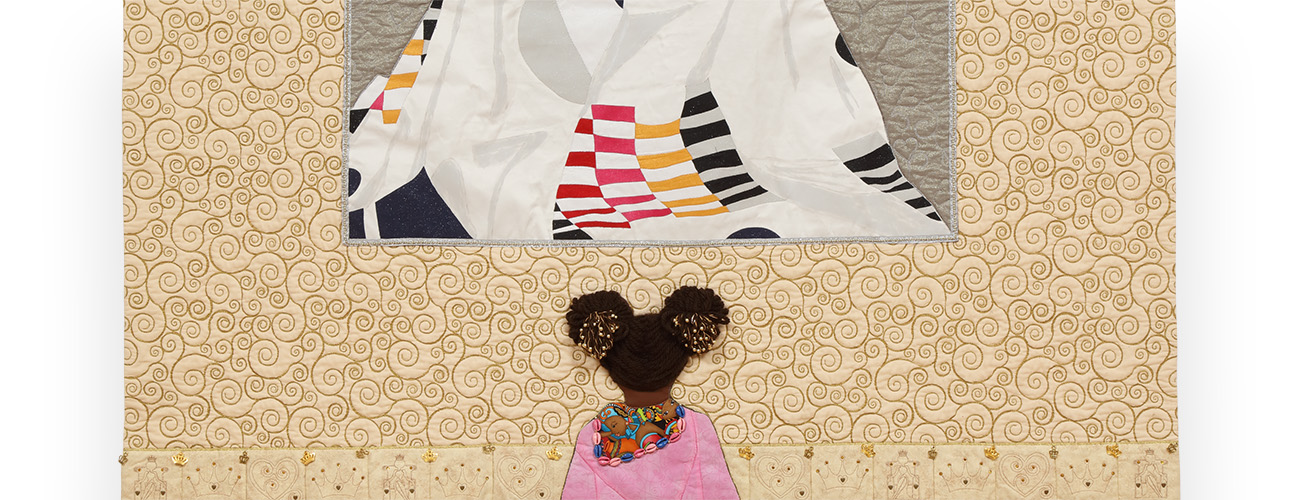Carolyn W. White
How can quilts made by Black women change the way we tell the history of abstract art?
Carolyn W. White (American, born 1950), Awestruck before an Unforgettable Nubian Queen, or From Gee’s Bend to Royalty (detail), 2021, cotton, rayon, polyester, ink, fabric markers, acrylic, yarn, plastic beads, cowrie shells, and Swarovski crystals, 60 × 72 inches, High Museum of Art, Atlanta, purchase with funds from the Friends of Folk Art, 2022.48. © Carolyn W. White.
The main purpose of abstraction in art is not to tell a story but to encourage involvement and imagination. Its objective is to provide viewers with an intangible and emotional experience, one that can be completely different for everyone depending on their personality and mood. In abstract art, assorted colors and shapes are placed together, creating a piece that represents something different for each admirer. Abstract art takes the traditional and makes it into something that is new and contemporary.
Traits that appear consistent in African American quilts are vertical stripes; bright colors; large designs; asymmetry; and improvisational, multiple and symbolic patterns. African American quilts are also known for their striking colors, abstract designs, strip-piecing, storytelling, and appliqué. The practice of quilting has been vitally important to the development of African American visual culture, and these quilts can be seen as powerful works of art that have held the hopes and dreams of African American families for generations.1
Quilting has been passed down as a medium for cultural and artistic expression. Lucy T. Pettway’s Birds in the Air (1981), which is held in the High’s collection, is one of my favorites. According to Black Art in America, Gee’s Bend quilters, including Pettway, “are known for upholding the tradition of quilting while simultaneously advancing it with abstract and conceptual designs. [. . .] This artistic expansion helped solidify quilting as a bona fide medium in the world of high art, as quilts were once marginalized as a low-skill craft practiced mainly by women and folk artists.”2 What art history calls abstraction is what the quilt culture calls modern—using nontraditional materials and nonrepresentational themes while disregarding convention.3
Abstraction is paring down something to its essence. Abstraction can be a disruptor for a museum collection and curation. Perhaps the word abstraction causes the reconsideration of the collection area, such as contemporary versus decorative arts versus self-taught. There may be additional challenges regarding hanging and displaying. Additionally, the personal tastes of judges, directors, and gatekeepers serve as barriers and create too many rules in evaluating the creation of spaces where more diverse voices would be welcome. Art museums and galleries may harbor bias around African American quilting and may neglect the art because of their own sexism and racism. Museums can be reactionary and materially bound to markets and stakeholders, subsequently not always being as altruistic in their aesthetic appraisals as they claim to be. Black art, in general, is devalued because it differs from the European model. It is necessary to locate or create a general category for African American quilts.
Consideration must be given to the story that an object tells because beauty is in the eye of the beholder. There must be courage to respect the interpretation provided by the artist. There is no rule that all art must be a masterpiece. The concept of a masterpiece can be problematic. Who decides the criteria? Judges can stifle the artist’s creativity. An end goal is implied, but for the artist, there is always more. Ultimately, what makes a masterpiece is having the eye that incorporates the elements of art and the principles of design.
